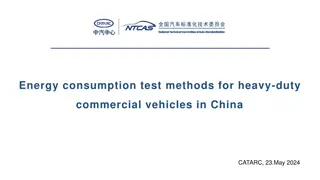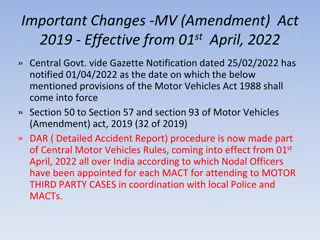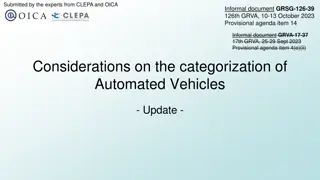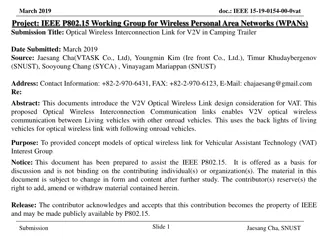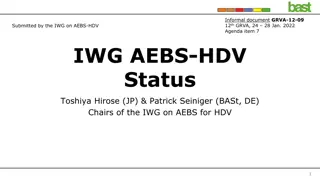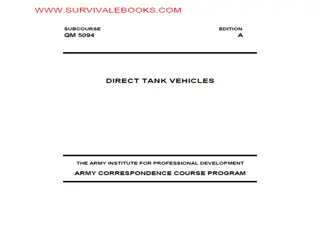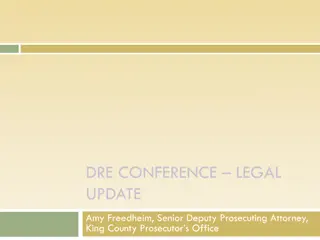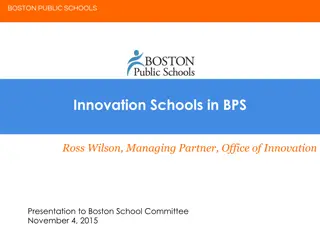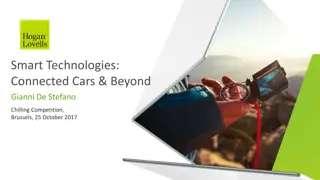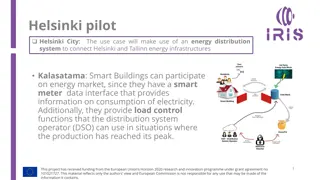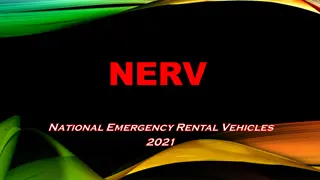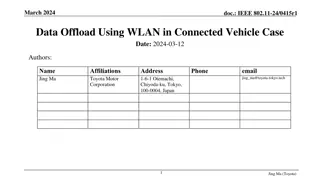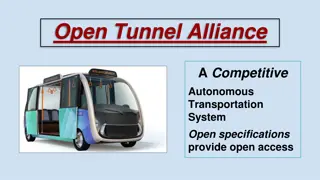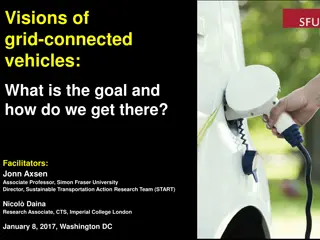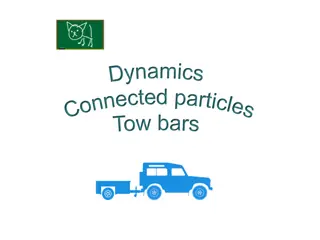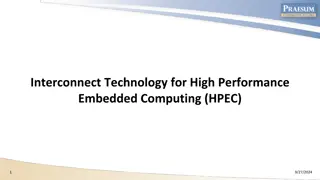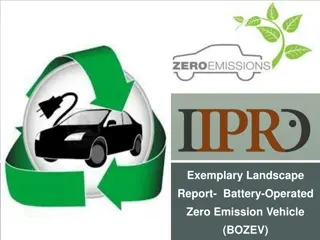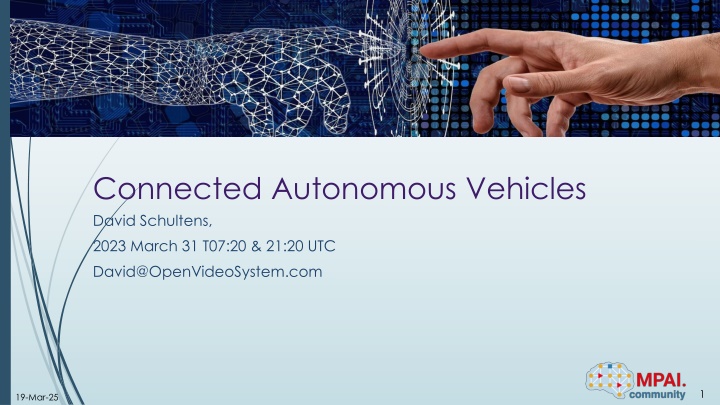
Refined AI Models for Connected Autonomous Vehicles
Enhance your understanding of connected autonomous vehicles with collaboratively refined AI models. Learn about partitioning AIM component revisions, improved interfaces, and licensed frameworks crucial for CAV safety, reliability, and explainability. Explore the evolution of CAV standards and the role of standard-based components in accelerating mass market adoption. Discover the essential elements and subsystems of CAV use case simulations for a comprehensive perspective on this cutting-edge technology.
Download Presentation

Please find below an Image/Link to download the presentation.
The content on the website is provided AS IS for your information and personal use only. It may not be sold, licensed, or shared on other websites without obtaining consent from the author. If you encounter any issues during the download, it is possible that the publisher has removed the file from their server.
You are allowed to download the files provided on this website for personal or commercial use, subject to the condition that they are used lawfully. All files are the property of their respective owners.
The content on the website is provided AS IS for your information and personal use only. It may not be sold, licensed, or shared on other websites without obtaining consent from the author.
E N D
Presentation Transcript
Connected Autonomous Vehicles David Schultens, 2023 March 31 T07:20 & 21:20 UTC David@OpenVideoSystem.com 1 19-Mar-25
Connected Autonomous Vehicles (CAV) Collaboratively and constantly refined AI Models Comparison of results in Simulation of Use Cases. Partitioning of AIM component revisions Improved interfaces and Licensed Framework Reference from MPAI Users/regulators: make sure that a CAV is safe, reliable, and explainable. Facilitated by CAV s componentization for Edge compute. Standard-based components accelerate a CAV mass market. CAV standards as milestones in a process for intercommunication, moving from research to standardization to deployment. 2 19-Mar-25
MPAI approach to standardisation AI AI Open market of components with standardises functions and Interfaces, competing in performance. Module (AIM) Module (AIM) Outputs Inputs User Agent AI Workflow (AIW) AI AIM Storage AI Module (AIM) Module (AIM) Controller Global Storage MPAI Store Communication Access MPAI-AIF enables independently sourced AI Modules having standardised interfaces to be executed in an environment with standardised APIs. 3 19-Mar-25
Connected Autonomous Vehicles (CAV) Collaboratively and constantly refined AI Models Comparison of results in Simulation of Use Cases. Partitioning of AIM component revisions Improved interfaces and Licensed Framework Reference from MPAI Users/regulators: make sure that a CAV is safe, reliable, and explainable. Facilitated by CAV s componentization for Edge compute. Standard-based components accelerate a CAV mass market. CAV standards as milestones in a process for intercommunication, moving from research to standardization to deployment. 4 19-Mar-25
Elements of a CAV Use Case Simulation Passenger Human Roadside Unit Traffic light Other vehicles CAV-enabled vehicles 5 19-Mar-25
CAV Subsystems containing AIM (modules) Environment Sensing Subsystem (ESS) Motion Actuation Subsystem (MAS) Autonomous Motion Subsystem (AMS) Human-CAV Interaction (HCI) 6 19-Mar-25
Functions of CAV subsystems Human-CAV interaction (HCI) responds to humans commands and queries, sensing activities during travel, activates other subsystems required by: 1. Humans as deemed necessary. 2. Environment by identified conditions. Environment Sensing Subsystem (ESS) acquires information from the environment Synthesis of sensor data creates and shares Basic Environment Representation (BER). Autonomous Motion Subsystem (AMS) builds a Full Environment Representation (FER) using internal and external edge compute (BERs from other CAVs and RSU) information to automatically route plan safely avoiding collision and efficiently flocking together. 1. Motion Actuation Subsystem (MAS) senses information from and 2. Actuates motion instructions in the physical environment and sends feedback. 7 19-Mar-25
HCI Autonomous Motion FWR Audio FER Commands Representation Full Envron.. Subsystem Viewer FWR Video Full Environment Representation Human CAV Text Autonomous Motion Subsystem Recognition Speaker Command Speech Speaker ID Audio Scene Description Audio (Indoor) Interaction Environment Sensing Subsystem Recognition Recognised Text Speech Response Speech Recognised Text Audio (Outdoor) Meaning Language Understanding S Personal Status Dialogue Processing Extraction Speech Personal Status Text Personal Status Face Object Human Object Video (Outdoor) Visual Scene Description Machine Face Physical Object Personal Status Display Identification Output Personal Status Human Object Text (Lang- Und) Physical Object ID Machine Gesture Physical Object User Agent Machine Text Recognition Face ID Video (Outdoor) Output Text Face Face Object Machine Speech Controller 8 MPAI Store Communication Global Storage 19-Mar-25
Radar Scene D. BER Radar Data R. Scene Description Radar Scene D. BER Lidar Data L. Scene Description Road Topology BER Camera Data Traff.Sig. Recognition Autonomous Motion Subsystem Camera Scene D. BER Ultrasound Scene Camera Data C. Scene Description ESS Data Fusion Ultrasound Data U. Scene Description BER User Agent Basic Environ. Represent. Map Scene D. BER Offline Map Data M. Scene Description Audio Data Audio Scene D. BER A. Scene Description Microphone Array Geom. GNSS Data Subsystem Spatial Attitude Spatial Attitude Spatial Attitude Generator Spatial Attitude Actuation Motion Other Environment Data Controller MPAI Store 9 19-Mar-25
Basic Environment Representation Other V2X Data Environment Subsystem Sensing Basic Environment Representation Full Environment Representation (FER) Fusion Full Environment Representation Full Environment Representation Environment Subsystem Human-CAV Sensing Interaction Env. Info. FER FER FER FER Feed back Alert Route Planner Path Planner Route Path Trajec-- tory Obstacle Motion Trajec-- tory Avoider Planner Command Destination Command Issuer Subsystem Actuation R. State Motion R. State R. State R. State Feedback User Agent FeedBack Route Trajectory Trajectory Path Decision Recorder Controller MPAI Store Communication Offline Map Global Storage 10 19-Mar-25
Accelerometer Speedometer Environment Sensing Subsystem (ESS) Spatial Attitude Generation Spatial Attitude Odometer Other Environment Data User Agent Motion Road wheel motor Commands Autonomous Motion Subsystem (AMS) Command Interpreter Road wheel direction Feedback Brakes Controller Global Storage MPAI Store Communication 11 19-Mar-25
Plans/1 MPAI is developing Technical Report Architecture of Connected Autonomous Vehicles (MPAI-CAV) defining 4 interconnected subsystems that: Understands human utterances (HCI). Plans a Route to reach a destination. Senses and builds a representation of the external Environment (BER). Exchanges BER with other CAVs and CAV-aware entities. Makes decisions about how to execute the Route (AMS). Actuates the motion (MAS). 12 19-Mar-25
Plans/2 For each Subsystem, the Technical Report provides: The Function of the Subsystem. The Functional Requirements of some I/O data. The Topology of the Components (AI Modules). For each Subsystem Component (AI Module) the Technical Report provides : The Function of the AIM The Functional Requirements of some I/O data. The Formats of some I/O data. 13 19-Mar-25
Join MPAI Share the fun Build the future! We look forward to your participation in this exciting project! https://mpai.community/ 14 19-Mar-25


